In Japanese, iteration marks are symbols which can be used to repeat parts of a word. The most common mark, 々, is written instead of a repeated kanji. The marks ゝゞヽヾ are written instead of a repeated kana. Besides those, there's also a long く mark, this thing 〻, and the ditto mark 〃.
Usage Frequency
Only two iteration marks are normally used in modern Japanese (々〃). The rest are only used seen in hand-writing or creatively, e.g. in titles, and are avoided in official documents, causing them to become rarer and rarer over time (ゝゞヽヾ〻〱〲).
So don't go around writing them just because you've found out about them today.
Text Direction
Also, keep in mind that Japanese can be written horizontally or vertically. Some iteration marks are easier to type on a computer, so they are used online, and in horizontal text. By contrast, some iteration marks are either too hard to type, or require vertical writing, so basically nobody writes them online.
Note: this page contains a bit of vertical text, which your browser may or may not support.
Names of Iteration Marks
Although the iteration marks do have official names, generally people don't really know those names, and in some cases don't even know what to call them. But, for reference:
Iteration marks are known by the names of:
- kurikaeshi-fugou
繰り返し符号
Iteration mark.
"Repetition" mark. - odoriji
踊り字
Dancing character. - kasaneji
重ね字
Stacking character. - onaji
同じ
"Same."
々 is specifically known by the names of:
- noma
ノマ
(because of its appearance.) - dou-no-ji-ten
同の字点
Character mark of "same."
ゝゞヽヾ are specifically known by the name of:
- ichi-no-ji-ten
一の字点
Character mark of "one."
(because it looks like 一.)
〻 is specifically known by the name of:
- ni-no-ji-ten
二の字点 - Character mark of "two."
(because it looks like 二, also it's two strokes.) - yusuri-ten
揺すり点
Shaking mark.
(because it looks like your hand is trembling as you wrote it.)
The long 〱〲 is specifically known by the name of:
- ku-no-ji-ten
くの字点
Character mark of "ku."
(because it looks like く.)
〃, the ditto mark, is known by the names of:
- nono-ji-ten
ノノ字点
Character mark of "ノノ.")
(because it looks like ノノ.)
(I guess nono-no-ji-ten ノノの字点 had too many no's...) - nono-ten
ノノ点
ノノ mark. - onajiku kigou
同じく記号
Ditto mark.
"Same-thing" symbol.
How to Type
Iteration marks can be typed by typing following words and trying to convert. It should appear somewhere in the conversion list of the IME:
- ku-ri-ka-e-shi
くりかえし (繰り返し)
"Repeat." - do-u
どう (同)
"Same." - o-na-ji
おなじ (同じ)
"Same."
Personally I prefer typing kurikaeshi but ymmv.
In the case of 々, typing a word that contains it normally converts to it too, e.g.: hitobito converts to人々 normally, not to 人人.
About Accents
In Japanese, sometimes the first syllable of a suffix gets accented with a dakuten 濁点 diacritic. This is called rendaku 連濁, and may even happen in words that repeat themselves.
Like hitobito ひとびと.
You'll notice that iteration marks in Japanese can handle such cases.
ゝヽ〱 have accented ゞヾ〲 counterparts. 々 does not, but it repeats the kanji characters which themselves can't have accents anyway.
Repeating Kana
The ichi-no-ji-ten ゝヽ repeats the previous hiragana and katakana respectively, and they have accented versions ゞヾ.
They can also be used to repeat multiple kana at once.
Confusingly, sometimes this can be done by writing the same number of iteration marks as repeated kana, but other times a single mark is used to indicate the kana of a word repeats itself:
| romaji | With two marks | With one mark |
|---|---|---|
| wakuwaku | わくヽヽ | わくヽ |
| tokidoki | ときヾヽ | ときヾ |
| dokidoki | ドキヾヽ | ドキヾ |
Repeating Kanji
The most commonly used mark, dou-no-ji-ten 々, repeats the previous kanji.
Sometimes, you might see multiple 々 repeating multiple kanji at once. The post-war orthographic reforms deemed this invalid, but it can still be found around.
- Context: a teacher brings a bikini to a school pool, gets reprimanded for it.
- {jun na} danshi niwa chotto shigeki-teki kashira~
純な男子にはちょっと刺激的かしらー
Is [it] too provocative for the {pure} boys, [I wonder]? - soretomo {sukuuru mizugi no} hou ga {kuru} mono kashira
それともスクール水着の方がくるものかしら
Or would [it] {[be more provocative]} if [it] {was a school swimsuit}}?- pin to kuru
ピンとくる
To click (in the sense of getting an idea). To have an epiphany.
To appeal someone greatly. To fit one's tastes perfectly.
- pin to kuru
- sore wa kojinkojin de...
それは個人々々で・・・
That varies from person to person...
〻
The ni-no-ji-ten 〻 works in a way very similar to 々, in that it looks like it just repeats the kanji before it.
masumasu 益〻
= 益〻 vertically.
sorezore 夫〻
= 夫〻 vertically.
The difference between 々 and 〻 lies in the origin of the words, and, consequently, the readings of the kanji that represent those words. Words of Japanese origin, with kun'yomi readings, would get the 〻 iteration mark, while those with the Chinese on'yomi readings would get the 々 mark.
For example, iro 色, "color," is a Japanese word. So you can write it "various," as iroiro 色〻. Likewise: samazama 様〻, tokidoki 時〻, iyoiyo 愈〻, and so on.
Meanwhile, the repeated morpheme of dandan 段々 is an on'yomi reading. So you can't spell it with 〻 instead.
There are also a bunch of words that repeat themselves that can be read with either readings:
- hibi 日〻
- nichinichi 日々
- toshidoshi 年〻
- nen'nen 年々
Note that from the way it's written, trembling downwards, you can guess it makes more sense in vertical writing.
Nowadays it's normal to use 々 instead of 〻, and most IME's will convert the words above to 々 but not to 〻. You'd have to type the 〻 separately if you want to write that way. (to be honest, it won't even show in my IME no matter what I type, so I've been copy-pasting it.)
Also, since 々 can be used instead of 〻 now, there seems to be no real reason to use 〻 in typed text, rendering it effectively obsolete or shelving it into "informal" handwriting.
Long Ku く
The long く character, ku-no-ji-ten くの字点, is an iteration mark that can repeat two or three characters before it. Because it repeats at least two characters, it's normally written twice as long as a normal character, and it looks like a stretched く.
Writing 〱
To have an idea of how this long ku く is written, here's someone actually writing it:
Although it looks like a ku く, it's technically not that kana, but a separate symbol. In Unicode, 〱〲 represent it, but those are pretty useless since they aren't twice as big than a normal character. For this reason, three characters exist for its halves:
〳 〴〵
That is, vertically it would look like this:
〳〴
〵〵
A long ku く, ain't it?
Horizontally, it's rendered as a he へ. That's because, vertically, the top part, 〳. comes before the bottom part, 〵, so if you type them horizontally in the same order:
〳〵
Sometimes /\, slashes, are written instead.
Ku-no-Ji-Ten Usage
The ku-no-ji-ten 〱〲 can repeat two or three characters at once. The simplest usage would be repeating the kana of words that repeat themselves, such as onomatopoeia or mimetic words:
It may also repeat multiple kanji.
bakabakashii 馬鹿馬鹿しい
= 馬鹿〳〵しい vertically.
And it may also repeat mixed kanji and kana, that is, words that contain okurigana.
kawarigawari 代り代り
= 代り〴〵 vertically.
Also note that in the example above the word is kawari-gawari, not kawari-kawari. That is: the pronunciation of the repeated part is affected by rendaku, so it gets accented. Likewise, in this case, the accented 〲 is used instead of 〱.
This is even though the 〱-less version (代り代り) didn't have an accent. After all, you don't accent kanji characters like 代.
〃 Ditto Mark
The nono-ji-ten ノノ字点, the Japanese ditto mark, is used to repeat the text of a previous line.
This is a mark that many languages have, even English, so you may know how it works already.
In vertical text, dou 仝, or doujou 同上, "same as above," are used instead as a ditto for the previous line (which would be to the right in this case, not above).
The ditto looks like double quotes used in Japanese, but is a different thing entirely.
References
- 【字学】 「年年歳歳花相似─歳歳年年人不同」 唐・劉廷芝 {々 二の字点・カンクリ}の乱用を脱し{〻 二の字点・ピリピリ}再考 - robundo.com/salama-press-club
A comment on 々〻 usage.
(warning: rather bloody historic drawing in page.) - 日本語横書きにおける踊り字の使い方 - okwave.jp
User asks about using iteration marks in horizontal text.
(posted in 2000, 18 years ago.)- (regarding ヽヾゝゞ〃)
"I know the last is called nono-ten, but the rest I don't know."
一番最後のが「ノノ点」と言われていることは知っていますが、それ以外は知りません - "I have never seen ゝ used in newspapers."
新聞で「ゝ」なんか使われているのを私は見たことがないですね。 - "You don't see ヽヾゝゞ"
「ヽ ヾ ゝ ゞ」は見ませんね
- (regarding ヽヾゝゞ〃)
- くりかえし符号の使ひ方 - bunka.go.jp
How to use iteration marks.
Published in year 21 of the Shouwa era, 昭和21, a.k.a. 1946. (see Years and Japanese Eras.)
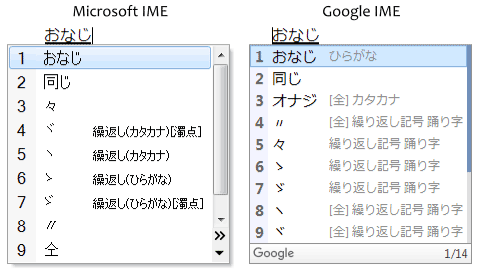
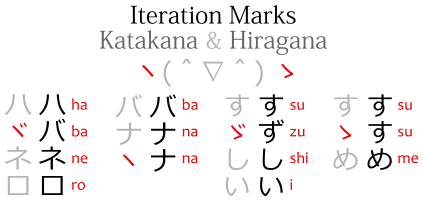
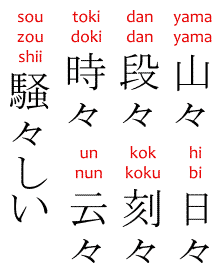
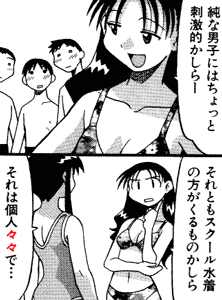
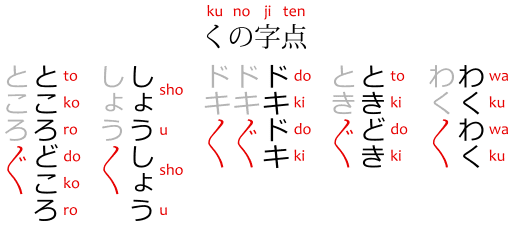
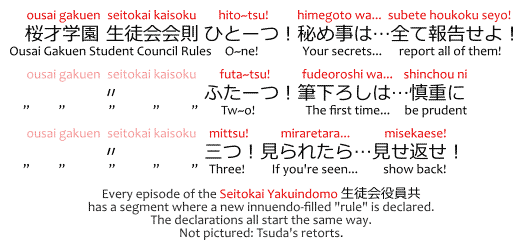
can u please make a article about english furigana in kanji ?
ReplyDeletethis is very common in manga, anime episodes and movies's title.
example :
名探偵コナン から紅くれないの 恋歌 (ラブレター)
the title is not Meitantei Conan : Kara Kurenai no Renka.
the title is Meitantei Conan : Kara Kurenai no Rabu Retta (Love Letter)
I have made on already.
DeleteSee: gikun 義訓